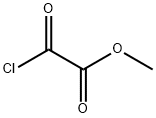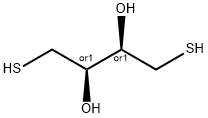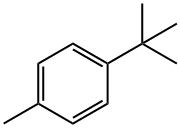METHYL OXALYL CHLORIDE
Synonym(s):Methyl 2-chloro-2-oxoacetate;Methyl oxalyl chloride;Monomethyl oxalyl chloride;Methyl chloroglyoxalate;Chloroglyoxylic acid methyl ester
- CAS NO.:5781-53-3
- Empirical Formula: C3H3ClO3
- Molecular Weight: 122.51
- MDL number: MFCD00000705
- EINECS: 227-307-4
- SAFETY DATA SHEET (SDS)
- Update Date: 2024-08-17 21:30:02

What is METHYL OXALYL CHLORIDE?
Chemical properties
CLEAR LIQUID
The Uses of METHYL OXALYL CHLORIDE
Methyl oxalyl chloride is used as a synthetic reagent. It serves as a reagent in the synthesis of fused coumarins, substituted isoxazoles and heterocycles. Further, it is used in intramolecular Wittig reactions, and iron-mediated cleavage of C-C bonds.
The Uses of METHYL OXALYL CHLORIDE
Reactant involved in:
- Regioselective synthesis of fused coumarins
- Cyclization to form substituted isoxazoles and heterocycles
- Intramolecular Wittig reactions
- Silyl enol ether acylation
- Iron-mediated cleavage of C-C bonds
Properties of METHYL OXALYL CHLORIDE
| Boiling point: | 118-120 °C (lit.) |
| Density | 1.332 g/mL at 25 °C (lit.) |
| refractive index | n |
| Flash point: | 116 °F |
| storage temp. | Inert atmosphere,2-8°C |
| solubility | Chloroform (Slightly), Ethyl Acetate |
| form | Liquid |
| color | Clear |
| Odor | Acrid |
| Water Solubility | Miscible with water. |
| Sensitive | Moisture Sensitive |
| BRN | 1071541 |
| Stability: | Hygroscopic |
| CAS DataBase Reference | 5781-53-3(CAS DataBase Reference) |
| EPA Substance Registry System | Acetic acid, chlorooxo-, methyl ester (5781-53-3) |
Safety information for METHYL OXALYL CHLORIDE
| Signal word | Danger |
| Pictogram(s) |
 Flame Flammables GHS02  Corrosion Corrosives GHS05  Exclamation Mark Irritant GHS07 |
| GHS Hazard Statements |
H226:Flammable liquids H314:Skin corrosion/irritation H335:Specific target organ toxicity, single exposure;Respiratory tract irritation |
| Precautionary Statement Codes |
P210:Keep away from heat/sparks/open flames/hot surfaces. — No smoking. P233:Keep container tightly closed. P240:Ground/bond container and receiving equipment. P280:Wear protective gloves/protective clothing/eye protection/face protection. P303+P361+P353:IF ON SKIN (or hair): Remove/Take off Immediately all contaminated clothing. Rinse SKIN with water/shower. P305+P351+P338:IF IN EYES: Rinse cautiously with water for several minutes. Remove contact lenses, if present and easy to do. Continuerinsing. |
Computed Descriptors for METHYL OXALYL CHLORIDE
| InChIKey | ZXUQEPZWVQIOJE-UHFFFAOYSA-N |
Abamectin manufacturer
New Products
4-AMINO-TETRAHYDRO-PYRAN-4-CARBOXYLIC ACID HCL 4-(Dimethylamino)tetrahydro-2H-pyran-4-carbonitrile 4-Aminotetrahydropyran-4-carbonitrile Hydrochloride (R)-3-Aminobutanenitrile Hydrochloride 3-((Dimethylamino)methyl)-5-methylhexan-2-one oxalate 1,4-Dioxa-8-azaspiro[4.5]decane 5-Bromo-2-nitropyridine Nimesulide BP Aceclofenac IP/BP/EP Diclofenac Sodium IP/BP/EP/USP Mefenamic Acid IP/BP/EP/USP Ornidazole IP Diclofenac Potassium THOMAIND PAPER PH 2.0 TO 4.5 1 BOX BUFFER CAPSULE PH 9.2 - 10 CAP SODIUM CHLORIDE 0.1N CVS ALLOXAN MONOHYDRATE 98% PLATINUM 0.5% ON 3 MM ALUMINA PELLETS (TYPE 73) LITHIUM AAS SOLUTION 2-Bromo-1-(bromomethyl)-3-chloro-5-nitrobenzene 2-Bromo-3-nitroaniline N-(3-Hydroxypropyl)-N-methylacetamide 3-Bromo-6-chloropyridazine 4-ethyl-3-nitrobenzoic acidRelated products of tetrahydrofuran








You may like
-
 Methyl oxalyl chloride CAS 5781-53-3View Details
Methyl oxalyl chloride CAS 5781-53-3View Details
5781-53-3 -
 Methyl oxalyl chloride 97% CAS 5781-53-3View Details
Methyl oxalyl chloride 97% CAS 5781-53-3View Details
5781-53-3 -
 Methyl oxalyl chloride, 96% CAS 5781-53-3View Details
Methyl oxalyl chloride, 96% CAS 5781-53-3View Details
5781-53-3 -
 Methyl Chloroglyoxylate CAS 5781-53-3View Details
Methyl Chloroglyoxylate CAS 5781-53-3View Details
5781-53-3 -
 Methyl chlorooxoacetate CAS 5781-53-3View Details
Methyl chlorooxoacetate CAS 5781-53-3View Details
5781-53-3 -
 5781-53-3 Methyl chlorooxoacetate 99%View Details
5781-53-3 Methyl chlorooxoacetate 99%View Details
5781-53-3 -
 5781-53-3 98%View Details
5781-53-3 98%View Details
5781-53-3 -
 Lithium ClavulanateView Details
Lithium ClavulanateView Details
61177-44-4
Statement: All products displayed on this website are only used for non medical purposes such as industrial applications or scientific research, and cannot be used for clinical diagnosis or treatment of humans or animals. They are not medicinal or edible.